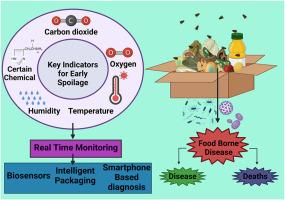检测和分析食品质量的生物传感器:将化学传感器与纳米技术相结合
IF 15.4
1区 农林科学
Q1 FOOD SCIENCE & TECHNOLOGY
引用次数: 0
摘要
食源性疾病仍然是全球的一个主要公共卫生问题,每年影响数百万人。对更安全、更可持续的食品系统的需求导致了旨在实时监测和分析食品质量的卫生设备的发展。生物传感器和智能包装等技术已成为应对食品安全挑战的关键。本研究探讨了将先进的健康设备整合到食品质量监测系统中,强调了它们提高食品安全和可持续性的潜力。生物传感器、智能手机集成和智能包装的最新进展增强了食品质量的实时监测。检测氧气、二氧化碳、pH值、湿度和腐败指标的技术为食品安全提供了可行的见解。基于智能手机的诊断和纳米技术支持的生物传感器使人们能够负担得起和获得,从而应对食源性疾病和减少废物的全球挑战。然而,扩展这些技术需要克服成本、互操作性和标准化等挑战。从文献调查中可以得出结论,生物传感器设备代表了食品安全和质量保证的变革方法。通过克服现有挑战,这些技术有可能显著减少食源性疾病并改善全球粮食可持续性。本文章由计算机程序翻译,如有差异,请以英文原文为准。

Biosensor to detect and analyze food quality: Integrating chemical sensors with nanotechnology
Foodborne illnesses continue to be a major public health issue around the globe, impacting millions of individuals annually. The demand for safer, more sustainable food systems has led to the development of health devices intended to monitor and analyze food quality in real time. Technologies like biosensors and intelligent packaging have become essential in addressing food safety challenges. The present study explores the integration of advanced health devices into food quality monitoring systems, emphasizing their potential to improve food safety and sustainability. Recent advancements in biosensors, smartphone integration, and intelligent packaging have enhanced real-time food quality monitoring. Technologies detecting oxygen, carbon dioxide, pH, humidity, and spoilage indicators provide actionable insights into food safety. Smartphone-based diagnostics and nanotechnology-enabled biosensors enable affordability and accessibility, addressing global challenges of foodborne illnesses and waste reduction. However, scaling these technologies requires overcoming challenges like cost, interoperability, and standardization. It can be concluded from the literature survey that biosensor devices represent a transformative approach to food safety and quality assurance. By overcoming existing challenges, these technologies have the potential to significantly reduce foodborne illnesses and improve global food sustainability.
求助全文
通过发布文献求助,成功后即可免费获取论文全文。
去求助
来源期刊

Trends in Food Science & Technology
工程技术-食品科技
CiteScore
32.50
自引率
2.60%
发文量
322
审稿时长
37 days
期刊介绍:
Trends in Food Science & Technology is a prestigious international journal that specializes in peer-reviewed articles covering the latest advancements in technology, food science, and human nutrition. It serves as a bridge between specialized primary journals and general trade magazines, providing readable and scientifically rigorous reviews and commentaries on current research developments and their potential applications in the food industry.
Unlike traditional journals, Trends in Food Science & Technology does not publish original research papers. Instead, it focuses on critical and comprehensive reviews to offer valuable insights for professionals in the field. By bringing together cutting-edge research and industry applications, this journal plays a vital role in disseminating knowledge and facilitating advancements in the food science and technology sector.
 求助内容:
求助内容: 应助结果提醒方式:
应助结果提醒方式:


